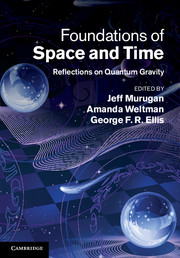Book contents
- Frontmatter
- Contents
- List of contributors
- 1 The problem with quantum gravity
- 2 A dialogue on the nature of gravity
- 3 Effective theories and modifications of gravity
- 4 The small-scale structure of spacetime
- 5 Ultraviolet divergences in supersymmetric theories
- 6 Cosmological quantum billiards
- 7 Progress in RNS string theory and pure spinors
- 8 Recent trends in superstring phenomenology
- 9 Emergent spacetime
- 10 Loop quantum gravity
- 11 Loop quantum gravity and cosmology
- 12 The microscopic dynamics of quantum space as a group field theory
- 13 Causal dynamical triangulations and the quest for quantum gravity
- 14 Proper time is stochastic time in 2D quantum gravity
- 15 Logic is to the quantum as geometry is to gravity
- 16 Causal sets: discreteness without symmetry breaking
- 17 The Big Bang, quantum gravity and black-hole information loss
- 18 Conversations in string theory
- Index
- References
9 - Emergent spacetime
Published online by Cambridge University Press: 05 August 2012
- Frontmatter
- Contents
- List of contributors
- 1 The problem with quantum gravity
- 2 A dialogue on the nature of gravity
- 3 Effective theories and modifications of gravity
- 4 The small-scale structure of spacetime
- 5 Ultraviolet divergences in supersymmetric theories
- 6 Cosmological quantum billiards
- 7 Progress in RNS string theory and pure spinors
- 8 Recent trends in superstring phenomenology
- 9 Emergent spacetime
- 10 Loop quantum gravity
- 11 Loop quantum gravity and cosmology
- 12 The microscopic dynamics of quantum space as a group field theory
- 13 Causal dynamical triangulations and the quest for quantum gravity
- 14 Proper time is stochastic time in 2D quantum gravity
- 15 Logic is to the quantum as geometry is to gravity
- 16 Causal sets: discreteness without symmetry breaking
- 17 The Big Bang, quantum gravity and black-hole information loss
- 18 Conversations in string theory
- Index
- References
Summary
We give an introductory account of the AdS/CFT correspondence in the ½-BPS sector of N =4 super Yang-Mills theory. Six of the dimensions of the string theory are emergent in the Yang-Mills theory. In this chapter we suggest how these dimensions and local physics in these dimensions emerge. The discussion is aimed at non-experts.
Introduction
The problem of quantizing gravity has proved to be a difficult one. To solve this problem, it seems to be necessary to answer the question “What is spacetime?” This challenges the most basic assumptions we are used to making; a radical new idea may be needed. Further, the hope of any guidance from experiment seems to be out of the question. One might conclude that the situation is hopeless. Drawing on recent insights from the AdS/CFT correspondence, we are nonetheless, optimistic.
The AdS/CFT correspondence [1] claims an exact equality between N =4 super Yang-Mills theory in flat (3+1)-dimensional Minkowski spacetime and Type IIB string theory on an asymptotically AdS5×S5 background. Type IIB string theory is a theory of closed strings; at least within string perturbation theory, theories of closed strings provide a consistent UV completion of gravity. The fact that such an equality exists is highly unexpected and non-trivial, and (as we will try to convince the reader) can be used to gain insight into the nature of spacetime. George Ellis opened the Foundations of Space and Time workshop by holding up two fingers and asking “are there an infinite or a finite number of places a particle could occupy between my fingers?” We don't know the answer to George's question.
- Type
- Chapter
- Information
- Foundations of Space and TimeReflections on Quantum Gravity, pp. 164 - 184Publisher: Cambridge University PressPrint publication year: 2012
References
- 2
- Cited by



